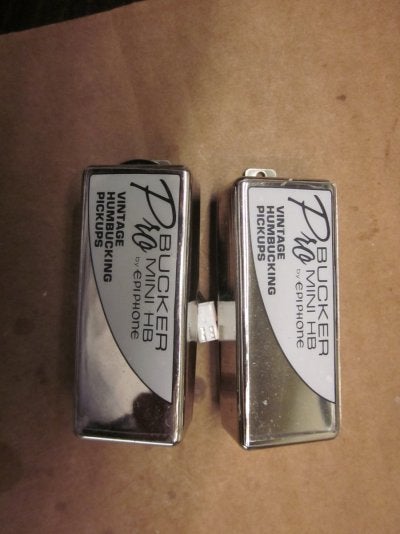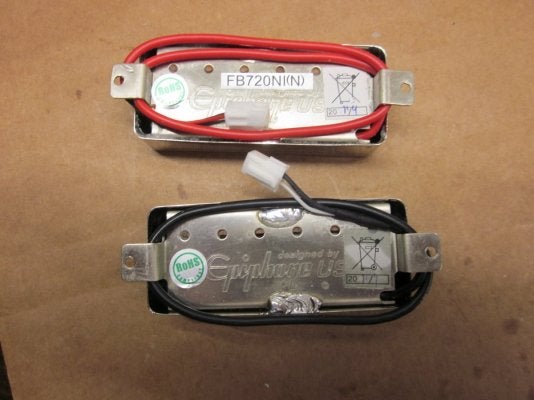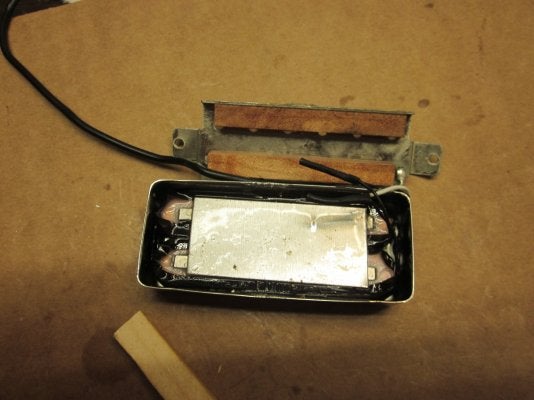old wrench
Poster Extraordinaire
There have lately been a few threads discussing Firebird pickups - both the original Gibson offerings and the more recent versions
"Real Firebirds" are distinguished from the similar appearing mini-humbuckers, by their lack of poles - they don't have the screws or slugs that are found on the mini-humbuckers - instead they have bar magnets placed inside the bobbin coils
The newer Epiphone Firebirds caught my attention, mainly because from the outside they look like the old Firebirds
I did some checking and found that they are selling for around $30 bucks shipped for a pair - bridge and neck
I suppose what really aroused my curiosity was the price - I wind my own version of the Firebird, and $30 bucks doesn't hardly cover my cost of the materials needed to wind a pair of Firebirds
So, I ordered a set so I could evaluate them and take a look and see what's under the cover
These are the pickups that Epiphone calls Pro-bucker Mini-HB, designed by Epiphone USA
That "Mini- Humbucker" term is sort of mis-leading - it could give the impression that these are mini-humbuckers, but the construction shows that they aren't


I removed the cover off the neck pickup by cutting through the soldered joint with a regular old utility knife - cutting through the joint works much better than trying to melt through the joint with a soldering iron

After I cut the cover loose, I warmed up the pickup with a heat gun to melt some of the wax potting so I could disassemble the guts - on Firebirds, the wax potting serves to hold and bind the parts together since there aren't any screws or mechanical fasteners to hold them together

You can see that the construction of these Epiphone pickups is true to the construction of the old Gibson Firebirds - nickel/silver baseplate, wood spacers, steel reflecting plate, and bar magnets inside the coil bobbins
Very similar construction, but further testing with a meter shows that these Firebirds are wound hotter than the old Gibsons, which is going to change their sound to some extent
The bridge pickup measures right at 8.20k DCR and the neck pickup measures 8.00k DCR
So, my finding show that yes, - these pickups are constructed like genuine old Gibson Firebirds, but they are wound hotter, which will give them a little different tone - more of a pronounced mid-range, and less treble compared to the originals
.
"Real Firebirds" are distinguished from the similar appearing mini-humbuckers, by their lack of poles - they don't have the screws or slugs that are found on the mini-humbuckers - instead they have bar magnets placed inside the bobbin coils
The newer Epiphone Firebirds caught my attention, mainly because from the outside they look like the old Firebirds
I did some checking and found that they are selling for around $30 bucks shipped for a pair - bridge and neck
I suppose what really aroused my curiosity was the price - I wind my own version of the Firebird, and $30 bucks doesn't hardly cover my cost of the materials needed to wind a pair of Firebirds
So, I ordered a set so I could evaluate them and take a look and see what's under the cover
These are the pickups that Epiphone calls Pro-bucker Mini-HB, designed by Epiphone USA
That "Mini- Humbucker" term is sort of mis-leading - it could give the impression that these are mini-humbuckers, but the construction shows that they aren't


I removed the cover off the neck pickup by cutting through the soldered joint with a regular old utility knife - cutting through the joint works much better than trying to melt through the joint with a soldering iron

After I cut the cover loose, I warmed up the pickup with a heat gun to melt some of the wax potting so I could disassemble the guts - on Firebirds, the wax potting serves to hold and bind the parts together since there aren't any screws or mechanical fasteners to hold them together

You can see that the construction of these Epiphone pickups is true to the construction of the old Gibson Firebirds - nickel/silver baseplate, wood spacers, steel reflecting plate, and bar magnets inside the coil bobbins
Very similar construction, but further testing with a meter shows that these Firebirds are wound hotter than the old Gibsons, which is going to change their sound to some extent
The bridge pickup measures right at 8.20k DCR and the neck pickup measures 8.00k DCR
So, my finding show that yes, - these pickups are constructed like genuine old Gibson Firebirds, but they are wound hotter, which will give them a little different tone - more of a pronounced mid-range, and less treble compared to the originals
.
